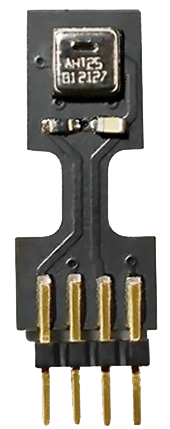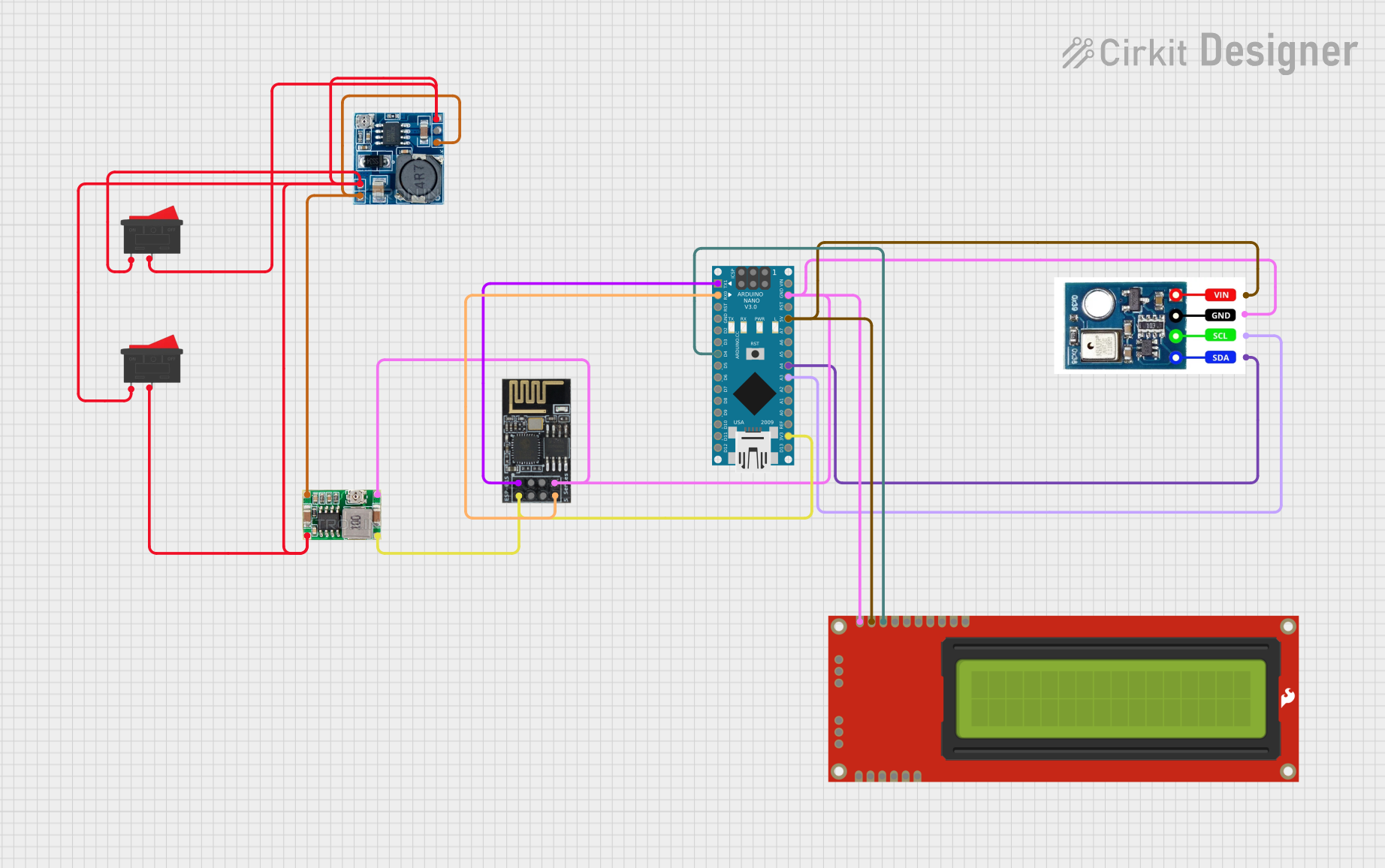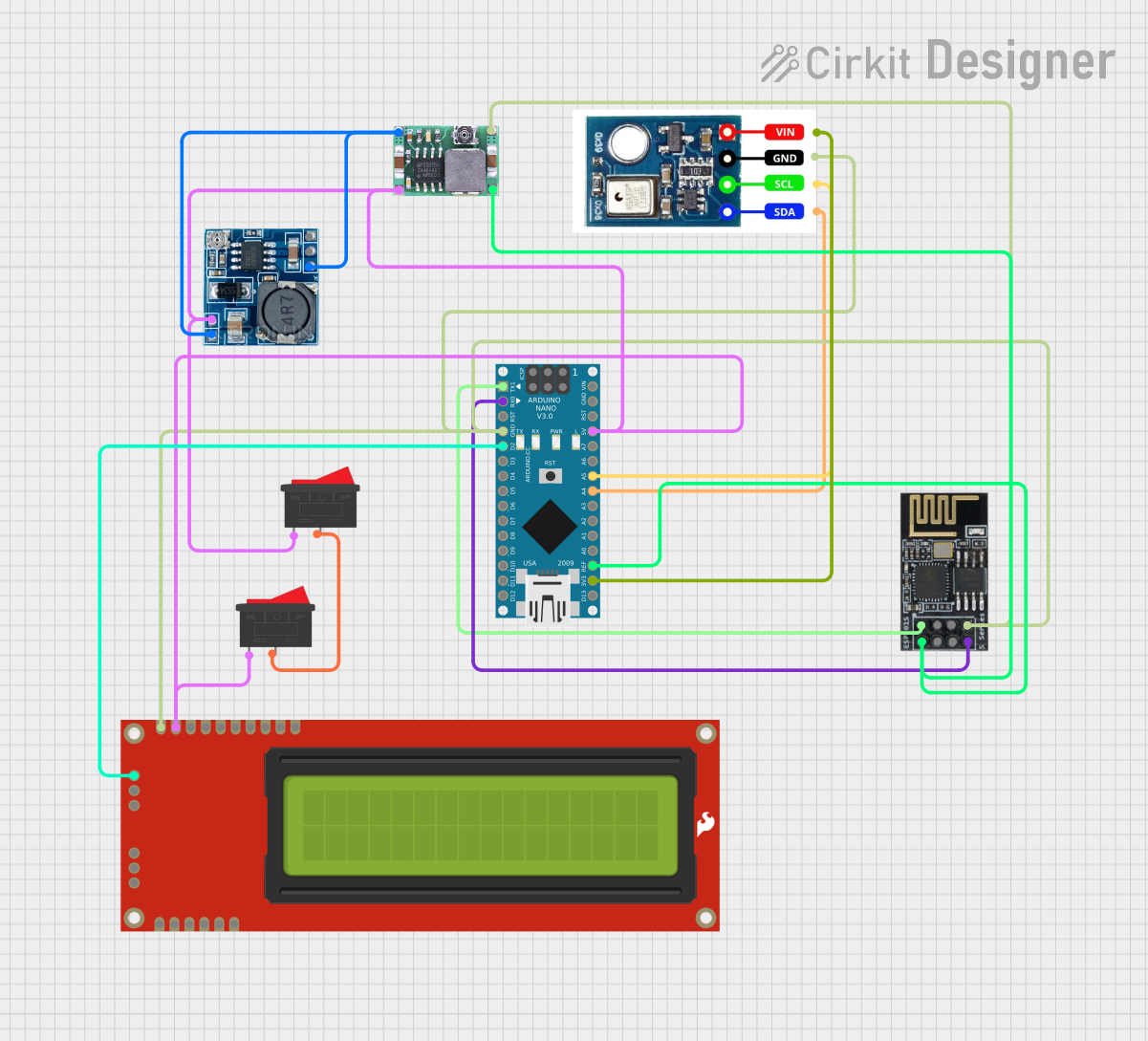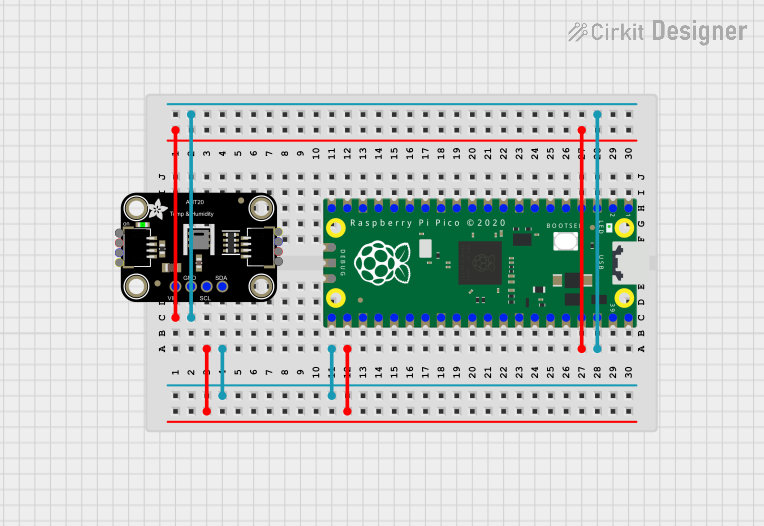
How to Use AHT25: Examples, Pinouts, and Specs

 Design with AHT25 in Cirkit Designer
Design with AHT25 in Cirkit DesignerIntroduction
The AHT25 is a digital temperature and humidity sensor manufactured by ASAIR (AOSONG). It is designed to provide accurate and reliable measurements of environmental conditions, making it ideal for a wide range of applications. The sensor features a built-in I2C interface, which simplifies integration with microcontrollers and other digital systems. With its high precision, low power consumption, and compact design, the AHT25 is well-suited for use in consumer electronics, HVAC systems, weather monitoring, and industrial automation.
Explore Projects Built with AHT25

 Open Project in Cirkit Designer
Open Project in Cirkit Designer
 Open Project in Cirkit Designer
Open Project in Cirkit Designer
 Open Project in Cirkit Designer
Open Project in Cirkit Designer
 Open Project in Cirkit Designer
Open Project in Cirkit DesignerExplore Projects Built with AHT25

 Open Project in Cirkit Designer
Open Project in Cirkit Designer
 Open Project in Cirkit Designer
Open Project in Cirkit Designer
 Open Project in Cirkit Designer
Open Project in Cirkit Designer
 Open Project in Cirkit Designer
Open Project in Cirkit DesignerCommon Applications
- Smart home devices (e.g., thermostats, air purifiers)
- Weather stations and environmental monitoring
- Industrial process control
- HVAC systems for temperature and humidity regulation
- IoT (Internet of Things) applications
Technical Specifications
The AHT25 sensor offers the following key technical specifications:
| Parameter | Value |
|---|---|
| Supply Voltage (VDD) | 2.0V to 5.5V |
| Typical Operating Voltage | 3.3V |
| Average Current Consumption | 0.25 mA (measuring) |
| Communication Interface | I2C |
| Temperature Range | -40°C to +85°C |
| Temperature Accuracy | ±0.3°C |
| Humidity Range | 0% to 100% RH |
| Humidity Accuracy | ±2% RH (20% to 80% RH) |
| Response Time | ≤8 seconds |
| Dimensions | 3.6mm x 2.4mm x 0.8mm |
Pin Configuration and Descriptions
The AHT25 has four pins, as described in the table below:
| Pin Name | Pin Number | Description |
|---|---|---|
| VDD | 1 | Power supply pin (2.0V to 5.5V) |
| GND | 2 | Ground pin |
| SDA | 3 | I2C data line |
| SCL | 4 | I2C clock line |
Usage Instructions
How to Use the AHT25 in a Circuit
- Power Supply: Connect the VDD pin to a 3.3V or 5V power source and the GND pin to ground.
- I2C Communication: Connect the SDA and SCL pins to the corresponding I2C pins on your microcontroller. Use pull-up resistors (typically 4.7kΩ) on both SDA and SCL lines if not already provided by your microcontroller.
- Initialization: Initialize the I2C interface on your microcontroller and configure the AHT25 for data acquisition.
- Data Reading: Send the appropriate I2C commands to read temperature and humidity data from the sensor.
Important Considerations
- Power Stability: Ensure a stable power supply to avoid measurement errors.
- Placement: Avoid placing the sensor in areas with high airflow or direct exposure to water droplets, as this may affect accuracy.
- I2C Address: The default I2C address of the AHT25 is
0x38. Ensure no address conflicts if multiple I2C devices are used. - Warm-Up Time: Allow the sensor to stabilize for at least 20ms after power-up before taking measurements.
Example Code for Arduino UNO
Below is an example of how to interface the AHT25 with an Arduino UNO using the I2C protocol:
#include <Wire.h>
// AHT25 I2C address
#define AHT25_ADDRESS 0x38
void setup() {
Wire.begin(); // Initialize I2C communication
Serial.begin(9600); // Initialize serial communication for debugging
// Initialize the AHT25 sensor
Wire.beginTransmission(AHT25_ADDRESS);
Wire.write(0xE1); // Send initialization command
Wire.endTransmission();
delay(20); // Wait for sensor to stabilize
}
void loop() {
// Request data from the AHT25 sensor
Wire.beginTransmission(AHT25_ADDRESS);
Wire.write(0xAC); // Trigger measurement command
Wire.write(0x33); // Data byte 1
Wire.write(0x00); // Data byte 2
Wire.endTransmission();
delay(80); // Wait for measurement to complete
// Read 6 bytes of data from the sensor
Wire.requestFrom(AHT25_ADDRESS, 6);
if (Wire.available() == 6) {
uint8_t data[6];
for (int i = 0; i < 6; i++) {
data[i] = Wire.read();
}
// Process temperature and humidity data
uint32_t humidity = ((uint32_t)data[1] << 12) | ((uint32_t)data[2] << 4) | (data[3] >> 4);
uint32_t temperature = ((uint32_t)(data[3] & 0x0F) << 16) | ((uint32_t)data[4] << 8) | data[5];
float humidityPercent = (humidity * 100.0) / 1048576.0; // Convert to percentage
float temperatureCelsius = (temperature * 200.0 / 1048576.0) - 50.0; // Convert to Celsius
// Print results to the serial monitor
Serial.print("Humidity: ");
Serial.print(humidityPercent);
Serial.println(" %");
Serial.print("Temperature: ");
Serial.print(temperatureCelsius);
Serial.println(" °C");
}
delay(2000); // Wait 2 seconds before the next reading
}
Troubleshooting and FAQs
Common Issues
No Data from Sensor:
- Cause: Incorrect I2C wiring or address mismatch.
- Solution: Verify the SDA and SCL connections and ensure the I2C address is set to
0x38.
Inaccurate Readings:
- Cause: Sensor placement in an unstable environment (e.g., high airflow).
- Solution: Place the sensor in a stable environment and ensure proper ventilation.
Initialization Failure:
- Cause: Insufficient warm-up time or incorrect initialization sequence.
- Solution: Allow at least 20ms for the sensor to stabilize after power-up and verify the initialization commands.
FAQs
Q: Can the AHT25 operate at 5V?
- A: Yes, the AHT25 supports a supply voltage range of 2.0V to 5.5V.
Q: Do I need external pull-up resistors for I2C?
- A: Yes, if your microcontroller does not have built-in pull-up resistors, you need to add external ones (typically 4.7kΩ).
Q: How often can I take measurements?
- A: The AHT25 has a response time of ≤8 seconds, but for most applications, a 2-second interval is sufficient.
This concludes the documentation for the AHT25 sensor.